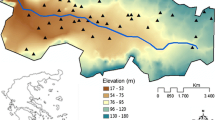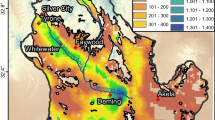Abstract
Geostatistical estimations of the hydraulic conductivity field (K) in the Carrizo aquifer, Texas, are performed over three regional domains of increasing extent: 1) the domain corresponding to a three-dimensional groundwater flow model previously built (model domain); 2) the area corresponding to the 10 counties encompassing the model domain (County domain), and; 3) the full extension of the Carrizo aquifer within Texas (Texas domain). Two different approaches are used: 1) an indirect approach where transmissivity (T) is estimated first and K is retrieved through division of the T estimate by the screen length of the wells, and; 2) a direct approach where K data are kriged directly. Due to preferential well screen emplacement, and scarcity of sampling in the deeper portions of the formation (> 1 km), the available data set is biased toward high values of hydraulic conductivities. Kriging combined with linear regression, simple kriging with varying local means, kriging with an external drift, and cokriging allow the incorporation of specific capacity as secondary information. Prediction performances (assessed through cross-validation) differ according to the chosen approach, the considered variable (log-transformed or back-transformed), and the scale of interest. For the indirect approach, kriging of log T with varying local means yields the best estimates for both log-transformed and back-transformed variables in the model domain. For larger regional scales (County and Texas domains), cokriging performs generally better than other kriging procedures when estimating both (log T)∗ and T∗. Among procedures using the direct approach, the best prediction performances are obtained using kriging of log K with an external drift. Overall, geostatistical estimation of the hydraulic conductivity field at regional scales is rendered difficult by both preferential well location and preferential emplacement of well screens in the most productive portions of the aquifer. Such bias creates unrealistic hydraulic conductivity values, in particular, in sparsely sampled areas.
Similar content being viewed by others
References
Aboufirassi, M., and Marino, M. A., 1984, Cokriging of aquifer transmissivities from field measurements of transmissivity and specific capacity: Math. Geol., v. 16, no. 1, p. 19–35.
Ahmed, S., and de Marsily, G., 1987, Comparison of geostatistical methods for estimating transmissivity using data on transmissivity and specific capacity: Water Resour. Res., v. 23, no. 9, p. 1717–1737.
Anderson, M. P., 1997, Characterization of geological heterogeneity, in Dagan, G., and Neuman, S. P., eds., Subsurface flow and transport; a stochastic approach, International Hydrology Series: Cambridge University Press, Cambridge, U.K., v. 5, p. 23–43.
Armstrong, M., 1994, Is research in mining geostats as dead as a dodo? in Dimitrakopoulos, R., ed., Geostatistics for the next century, Quantitative Geology and Geostatistics: Kluwer Academic, Dordrecht, The Netherlands, v. 6, p. 303–312.
Bleines, C., Deraisme, J., Geffroy, F., Jeannée, N., Perseval, S., Rambert, F., Renard, D., and Touffait, Y., 2002, ISATIS Software Manual, 4th ed.: Géovariances, Fontainebleau, France, 645 p.
Bredehoeft, J. D., and Papadopulos, S. S., 1980, A method for determining the hydraulic properties of tight formations: Water Resour. Res., v. 16, no. 1, p. 233–238.
Castro, M. C., and Goblet, P., 2003, Calibration of regional groundwater flow models: Working toward a better understanding of site-specific systems: Water Resour. Res., v. 39, no. 6, art. 1172, doi: 10.1029/2002WR001653.
Castro, M. C., Goblet, P., Ledoux, E., Violette, S., and de Marsily, G., 1998b, Noble gases as natural tracers of water circulation in the Paris Basin 2. Calibration of a groundwater flow model using noble gas isotope data: Water Resour. Res., v. 34, no. 10, p. 2467–2483.
Castro, M. C., Jambon, A., de Marsily, G., and Schlosser, P., 1998a, Noble gases as natural tracers of water circulation in the Paris Basin 1. Measurements and discussion of their origin and mechanisms of vertical transport in the basin: Water Resour. Res., v. 34, no. 10, p. 2443–2466.
Chiles, J.-P., and Delfiner, P., 1999, Geostatistics. Modeling spatial uncertainty: Wiley, New York, 695 p.
Christensen, S., 1997, On the strategy of estimating regional-scale transmissivity fields: Ground Water, v. 35, no. 1, p. 131–139.
Davis, J. C., 2002, Statistics and data analysis in geology, 3rd ed.: Wiley, New York, 638 p.
Delhomme, J. P., 1974, La cartographie d'une grandeur physique à partir de données de différentes qualités (A cartographic method for assessing data with different reliabilities): Mémoires: Association Internationale des Hydrogéologues (Memoires: International Association of Hydrogeologists), v. 10, no. 1, p. 185–194.
Delhomme, J. P., 1979, Spatial variability and uncertainty in groundwater flow parameters; a geostatistical approach: Water Resour. Res., v. 15, no. 2, p. 269–280.
de Marsily, G., 1986, Quantitative hydrogeology: Academic Press, San Diego, 440 p.
Fabbri, P., 1997, Transmissivity in the geothermal Euganean Basin; a geostatistical analysis: Ground Water, v. 35, no. 5, p. 881–887.
Goovaerts, P., 1997, Geostatistics for natural resources evaluation: Oxford University Press, New York, 483 p.
Goovaerts, P., 1998, Ordinary cokriging revisited: Math. Geol., v. 30, no. 1, p. 21–42.
Goovaerts, P., 2000, Geostatistical approaches for incorporating elevation into the spatial interpolation of rainfall: J. Hydrol., v. 228, no. 1–2, p. 113–129.
Hamlin, H. S., 1988, Depositional and ground-water flow systems of the Carrizo–Upper Wilcox, South Texas, Report of Investigations 175: Bureau of Economic Geology, Austin, 61 p.
Hughson, L., Huntley, D., and Razack, M., 1996, Cokriging limited transmissivity data using widely sampled specific capacity from pump tests in an alluvial aquifer: Ground Water, v. 34, no. 1, p. 12–18.
Huntley, D., Nommensen, R., and Steffey, D., 1992, The use of specific capacity to assess transmissivity in fractured-rock aquifers: Ground Water, v. 30, no. 3, p. 396–402.
Isaaks, E. H., and Srivastava, R. M., 1989, An introduction to applied geostatistics: Oxford University Press, New York, 561 p.
Journel, A. G., 1980, The lognormal approach to predicting local distributions of selective mining unit grades: Math. Geol., v. 12, p. 285–303.
Journel, A. G., 1993, Geostatistics; roadblocks and challenges, in Soares, A., ed., Geostatistics Tróia '92, Quantitative Geology and Geostatistics: Kluwer Academic, Dordrecht, The Netherlands, v. 5, p. 213–224.
Journel, A. G., and Huijbregts, C. J., 1978, Mining geostatistics: Academic Press, London, 600 p.
Koltermann, C. E., and Gorelick, S. M., 1996, Heterogeneity in sedimentary deposits; a review of structure-imitating, process-imitating, and descriptive approaches: Water Resour. Res., v. 32, no. 9, p. 2617–2658.
Lavenue, M., and de Marsily, G., 2001, Three-dimensional interference test interpretation in a fractured aquifer using the pilot point inverse method: Water Resour. Res., v. 37, no. 11, p. 2659–2675.
Mace, R. E., 1997, Determination of transmissivity from specific capacity tests in a karst aquifer: Ground Water, v. 35, no. 5, p. 738–742.
Mace, R. E., and Smyth, R. C., 2003, Hydraulic properties of the Carrizo–Wilcox aquifer in Texas: Information for groundwater modeling, planning, and management, Report of Investigations 269: University of Texas at Austin, Bureau of Economic Geology, New Orleans, 40 p.
Neuman, S. P., 1982, Statistical characterization of aquifer heterogeneities; an overview, in Narasimhan, T. N., ed., Geol. Soc. Amer. Spectral Paper 189, p. 81–102.
Neuzil, C. E., 1994, How permeable are clays and shales?: Water Resour. Res., v. 30, no. 2, p. 145– 150.
Patriarche, D., Castro, M. C., and Goblet, P., 2004, Large-scale hydraulic conductivities inferred from three-dimensional groundwater flow and 4He transport modeling in the Carrizo aquifer, Texas: J. Geophys. Res., v. 109, no. B11, art. B11202, doi: 10.1029/2004JB003173.
Payne, J. N., 1972, Geohydrologic significance of Lithofacies of the Carrizo Sand of Arkansas, Louisiana, and Texas and the Meridian Sand of Mississippi, U. S. Geological Survey, Professional Paper 569-D: Washington, DC, 15 p.
Razack, M., and Huntley, D., 1991, Assessing transmissivity from specific capacity in a large and heterogeneous alluvial aquifer: Ground Water, v. 29, no. 6, p. 856–861.
Saito, H., and Goovaerts, P., 2000, Geostatistical interpolation of positively skewed and censored data in Dioxin-contaminated site: Environ. Sci. Technol., v. 34, no. 19, p. 4228–4235.
Wierenga, P. J., Hills, R. G., and Hudson, D. B., 1991, The Las-Cruces Trench site— Characterization, experimental results, and one-dimensional flow predictions: Water Resour. Res., v. 27, no. 10, p. 2695–2705.
Wladis, D., and Gustafson, G., 1999, Regional characterization of hydraulic properties of rock using air-lift data: Hydrogeol. J., v. 7, no. 2, p. 168–179.
Author information
Authors and Affiliations
Corresponding author
Rights and permissions
About this article
Cite this article
Patriarche, D., Castro, M.C. & Goovaerts, P. Estimating Regional Hydraulic Conductivity Fields—A Comparative Study of Geostatistical Methods. Math Geol 37, 587–613 (2005). https://doi.org/10.1007/s11004-005-7308-5
Received:
Accepted:
Issue Date:
DOI: https://doi.org/10.1007/s11004-005-7308-5




